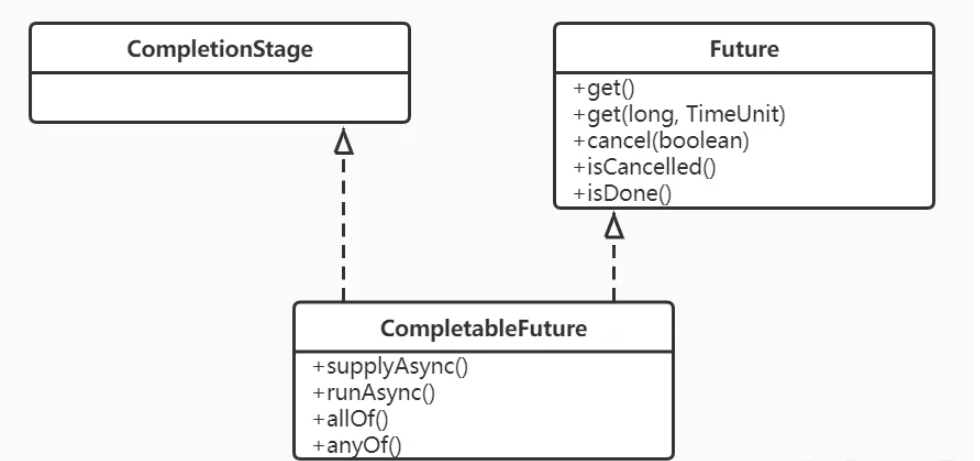这篇文章主要介绍“Java8并发新特性CompletableFuture怎么使用”的相关知识,小编通过实际案例向大家展示操作过程,操作方法简单快捷,实用性强,希望这篇“Java8并发新特性CompletableFuture怎么使用”文章能帮
这篇文章主要介绍“Java8并发新特性CompletableFuture怎么使用”的相关知识,小编通过实际案例向大家展示操作过程,操作方法简单快捷,实用性强,希望这篇“Java8并发新特性CompletableFuture怎么使用”文章能帮助大家解决问题。
各位小伙伴是否有一种感觉,整天大量时间沉迷于业务开发的同时,缺少对于一些技术更新的关注,忽略掉了很多实用又简单的方法,以往我们做异步任务的时候都习惯于使用Callable或者Runnable接口去实现,今天我们就来聊聊与之不同的CompletableFuture类。
CompletableFuture针对Future接口做了改进,相比Callable/Runnable接口它支持多任务进行链式调用、组合、多任务并发处理。很多时候我们在设计过程中会想在一个异步任务执行完成后,直接获取它的结果传递给下一个任务继续执行后续的流程,这时候CompletableFuture的作用就来了。
CompletableFuture类关系图:
从以下类图可以看到,CompletableFuture实现了Future和CompletionStage两个接口,Future提供了获取任务执行结果和任务执行状态的功能。 CompletionStage表示一个任务的执行阶段,提供了诸多方法支持了多任务的聚合功能。

supplyAsync与runAsync主要用于构建异步事件。
supplyAsync:带有返回值的异步任务,支持在默认线程池ForkJoinPool.commonPool()中完成异步任务,也可以使用自定义线程池执行异步任务,结果返回一个新的CompletableFuture,返回结果类型U。最终的任务执行结果可通过返回CompletableFuture对象的 get()/join() 方法获取返回值。
// 使用默认线程池public static <U> CompletableFuture<U> supplyAsync(Supplier<U> supplier) {...}// 使用自定义线程池Executorpublic static <U> CompletableFuture<U> supplyAsync(Supplier<U> supplier, Executor executor) {...}// ====================================demo华丽分割线============================================CompletableFuture<String> supplyAsyncFuture = CompletableFuture.supplyAsync(() -> { log.info("executing supplyAsync task ..."); return "this is supplyAsync";});// 进入阻塞获取异步任务结果log.info(supplyAsyncFuture.get()); // 输出结果:this is supplyAsyncrunAsync:不带返回值的异步任务,支持在默认线程池ForkJoinPool.commonPool()中完成异步任务,也可以使用自定义线程池执行异步任务,结果返回一个新的CompletableFuture,返回结果类型为Void,也就是无返回值。
public static CompletableFuture<Void> runAsync(Runnable runnable) {...}public static CompletableFuture<Void> runAsync(Runnable runnable, Executor executor) {...}// ====================================demo华丽分割线============================================CompletableFuture<Void> runAsyncFuture = CompletableFuture.runAsync(() -> { log.info("executing runAsync task ...");});runAsyncFuture.get();allOf:多个CompletableFuture任务并发执行,所有CompletableFuture任务完成时,返回一个新的CompletableFuture对象,其返回值为Void,也就是无返回值。
public static CompletableFuture<Void> allOf(CompletableFuture<?>... cfs) {...}// ====================================demo华丽分割线============================================// allOf,可传递返回值不同类型的future,最终结果按自己设计预期处理即可CompletableFuture<String> cf11 = CompletableFuture.supplyAsync(() -> { log.info("executing supplyAsync task cf11 ..."); return "this is supplyAsync";});CompletableFuture<String> cf12 = CompletableFuture.supplyAsync(() -> { log.info("executing supplyAsync task cf12 ..."); return "this is supplyAsync";});CompletableFuture<Void> allOfFuture = CompletableFuture.allOf(cf11, cf12);allOfFuture.get();anyOf:多个CompletableFuture任务并发执行,只要有一个CompletableFuture任务完成时,就会返回一个新的CompletableFuture对象,并返回该CompletableFuture执行完成任务的返回值。
public static CompletableFuture<Object> anyOf(CompletableFuture<?>... cfs) {...}// ====================================demo华丽分割线============================================CompletableFuture<String> cf21 = CompletableFuture.supplyAsync(() -> { log.info("executing supplyAsync task cf21 ..."); return "this is supplyAsync cf21";});CompletableFuture<String> cf22 = CompletableFuture.supplyAsync(() -> { log.info("executing supplyAsync task cf22 ..."); return "this is supplyAsync cf22";});CompletableFuture<Object> anyOfFuture = CompletableFuture.anyOf(cf21, cf22);log.info("{}", anyOfFuture.get()); // 输出结果:this is supplyAsync cf21或cf22join()和get()方法都是CompletableFuture对象基于阻塞的方式来获取异步任务执行结果。
get方法会抛出显示异常必须捕获处理,任务允许被中断抛出InterruptedException异常,通过带有超时时间的阻塞方式获取异步任务执行结果,超时等待无结果则中断任务抛出TimeoutException异常。
join方法会抛出未检查异常,与get()方法不同的是join()方法不允许被中断。
// 可中断,可设置超时时间public T get() throws InterruptedException, ExecutionException {...}public T get(long timeout, TimeUnit unit) throws InterruptedException, ExecutionException, TimeoutException {...}public T join() {...}CompletionStage表示一个任务的执行阶段,每个任务都会返回一个CompletionStage对象,可以对多个CompletionStage对象进行串行、并行或者聚合的方式来进行下阶段的操作,也就是说实现异步任务的回调功能。CompletionStage总共提供了38个方法来实现多个CompletionStage任务的各种操作, 接下来我们就针对这些方法分类来了解一下。
以下类型均有三种使用方式:
thenAccept:方法名不带Async的使用主线程同步执行回调函数,不做异步处理
thenAcceptAsync:方法名带Async,但是无executor参数的,使用默认线程池ForkJoinPool.commonPool异步执行任务
thenAcceptAsync:方法名带Async,有executor参数的,使用自定义线程池异步执行任务
依赖单个任务完成(thenAccept):由上一个CompletionStage任务执行完成的结果传递到action进行回调处理,即仅仅消费了上一个CompletionStage任务的返回值,回调处理结果无返回值。
// 不使用线程池,仅依赖当前线程执行,不做异步public CompletionStage<Void> thenAccept(Consumer<? super T> action);// 使用默认线程池ForkJoinPool.commonPool执行任务public CompletionStage<Void> thenAcceptAsync(Consumer<? super T> action);// 使用自定义线程池执行任务public CompletionStage<Void> thenAcceptAsync(Consumer<? super T> action, Executor executor);// ====================================demo华丽分割线============================================CompletableFuture.supplyAsync(() -> "this is supplyAsync") .thenAcceptAsync((result) -> { log.info("{} thenAcceptAsync", result); }).join(); // 输出结果:this is supplyAsync thenAcceptAsync依赖两个任务都完成(thenAcceptBoth):两个CompletionStage任务并发执行,必须都完成了才执行action回调处理,即仅仅消费了两个CompletionStage任务的返回值,回调处理结果无返回值。
public <U> CompletionStage<Void> thenAcceptBoth(CompletionStage<? extends U> other, BiConsumer<? super T, ? super U> action);// 原理同上,使用默认线程池执行异步任务public <U> CompletionStage<Void> thenAcceptBothAsync(CompletionStage<? extends U> other, BiConsumer<? super T, ? super U> action);// 原理同上,使用自定义线程池执行异步任务public <U> CompletionStage<Void> thenAcceptBothAsync(CompletionStage<? extends U> other, BiConsumer<? super T, ? super U> action, Executor executor);// ====================================demo华丽分割线============================================CompletableFuture<String> cf311 = CompletableFuture.supplyAsync(() -> "this is supplyAsync cf311");CompletableFuture<String> cf312 = CompletableFuture.supplyAsync(() -> "this is supplyAsync cf312");cf311.thenAcceptBothAsync(cf312, (r1, r2) -> { log.info("{} and {}", r1, r2);}).join();// 输出结果:this is supplyAsync cf311 and this is supplyAsync cf312依赖两个任务中的任何一个完成(acceptEither):两个CompletionStage任务并发执行,只要其中一个先完成了就携带返回值执行action回调处理,即仅仅消费了优先完成的CompletionStage任务的返回值,回调处理结果无返回值。
public CompletionStage<Void> acceptEither(CompletionStage<? extends T> other, Consumer<? super T> action);public CompletionStage<Void> acceptEitherAsync(CompletionStage<? extends T> other, Consumer<? super T> action);public CompletionStage<Void> acceptEitherAsync(CompletionStage<? extends T> other, Consumer<? super T> action, Executor executor);// ====================================demo华丽分割线============================================CompletableFuture<String> cf311 = CompletableFuture.supplyAsync(() -> "this is supplyAsync cf311");CompletableFuture<String> cf312 = CompletableFuture.supplyAsync(() -> "this is supplyAsync cf312");cf311.acceptEitherAsync(cf312, (r) -> { log.info(r); // 输出结果:this is supplyAsync cf311或cf312}).join();依赖单个任务完成(thenApply):由上一个CompletionStage任务执行完成的结果传递到action进行回调处理,即不止消费了上一个CompletaionStage任务的返回值,同时回调处理结果也有返回值
public <U> CompletionStage<U> thenApply(Function<? super T,? extends U> fn);public <U> CompletionStage<U> thenApplyAsync(Function<? super T,? extends U> fn);public <U> CompletionStage<U> thenApplyAsync(Function<? super T,? extends U> fn, Executor executor);// ====================================demo华丽分割线============================================CompletableFuture<String> cf32 = CompletableFuture.supplyAsync(() -> "this is supplyAsync") .thenApplyAsync(result -> result + " and thenApplyAsync");log.info(cf32.join()); // 输出结果:this is supplyAsync and thenApplyAsync依赖两个任务都完成(thenCombine):两个CompletionStage任务并发执行,必须都完成了才执行action回调处理,即不止消费了两个CompletaionStage任务的返回值,同时回调处理结果也有返回值。
public <U,V> CompletionStage<V> thenCombine(CompletionStage<? extends U> other, BiFunction<? super T,? super U,? extends V> fn);public <U,V> CompletionStage<V> thenCombineAsync(CompletionStage<? extends U> other, BiFunction<? super T,? super U,? extends V> fn);public <U,V> CompletionStage<V> thenCombineAsync(CompletionStage<? extends U> other, BiFunction<? super T,? super U,? extends V> fn, Executor executor);// ====================================demo华丽分割线============================================CompletableFuture<String> cf321 = CompletableFuture.supplyAsync(() -> "this is supplyAsync cf321");CompletableFuture<String> cf322 = CompletableFuture.supplyAsync(() -> "this is supplyAsync cf322");CompletableFuture<String> thenCombineFuture = cf321.thenCombineAsync(cf322, (r1, r2) -> { return r1 + " and " + r2;});log.info(thenCombineFuture.join());// 输出结果:this is supplyAsync cf321 and this is supplyAsync cf322依赖两个任务中的任何一个完成(applyToEither):两个CompletionStage任务并发执行,只要其中一个任务执行完成就会action回调处理,即不止消费了优先完成的CompletionStage的返回值,同时回调处理结果也有返回值。
// 原理同3.1的acceptEither,只不过applyToEither任务执行完成会返回一个带有返回值的CompletionStagepublic <U> CompletionStage<U> applyToEither(CompletionStage<? extends T> other, Function<? super T, U> fn);public <U> CompletionStage<U> applyToEitherAsync(CompletionStage<? extends T> other, Function<? super T, U> fn);public <U> CompletionStage<U> applyToEitherAsync(CompletionStage<? extends T> other, Function<? super T, U> fn, Executor executor);// ====================================demo华丽分割线============================================CompletableFuture<String> cf321 = CompletableFuture.supplyAsync(() -> "this is supplyAsync cf321");CompletableFuture<String> cf322 = CompletableFuture.supplyAsync(() -> "this is supplyAsync cf322");CompletableFuture<String> thenCombineFuture = cf321.applyToEitherAsync(cf322, (r) -> { return r;});log.info(thenCombineFuture.join());// 输出结果:this is supplyAsync cf321或cf322依赖单个任务完成(thenRun):单个CompletionStage任务执行完成回调action处理,即执行action回调方法无参数,回调处理结果也无返回值。
// 上一个CompletionStage任务执行完成后直接回调action处理,无返回值public CompletionStage<Void> thenRun(Runnable action);// 同上,使用默认线程池执行action处理public CompletionStage<Void> thenRunAsync(Runnable action);// 同上,使用自定义线程池执行action处理public CompletionStage<Void> thenRunAsync(Runnable action, Executor executor);// ====================================demo华丽分割线============================================CompletableFuture.runAsync(() -> { // TODO}).thenRunAsync(() -> { log.info("this is thenRunAsync"); // 输出结果:this is thenRunAsync}).join();依赖两个任务都完成(runAfterBoth):两个CompletionStage任务并发执行,必须两个任务都完成才执行action回调处理,即执行action回调方法无参数,回调处理结果也无返回值。
// 原理同3.1的thenAcceptBoth,只不过runAfterBoth的action回调处理不接收参数且任务执行完成无返回值public CompletionStage<Void> runAfterBoth(CompletionStage<?> other, Runnable action);// 同上,使用默认线程池执行action处理public CompletionStage<Void> runAfterBothAsync(CompletionStage<?> other, Runnable action);// 同上,使用自定义线程池执行action处理public CompletionStage<Void> runAfterBothAsync(CompletionStage<?> other, Runnable action, Executor executor);// ====================================demo华丽分割线============================================CompletableFuture<String> cf331 = CompletableFuture.supplyAsync(() -> "this is supplyAsync cf331");CompletableFuture<String> cf332 = CompletableFuture.supplyAsync(() -> "this is supplyAsync cf332");cf331.runAfterBoth(cf332, () -> { log.info("this is runAfterBoth");}).join();// 输出结果:this is runAfterBoth依赖两个任务中的任何一个完成(runAfterEither):两个CompletionStage任务并发执行,只需其中任何一个任务完成即可回调action处理,即执行action回调方法无参数,回调处理结果也无返回值。
public CompletionStage<Void> runAfterEither(CompletionStage<?> other, Runnable action);public CompletionStage<Void> runAfterEitherAsync(CompletionStage<?> other, Runnable action);public CompletionStage<Void> runAfterEitherAsync(CompletionStage<?> other, Runnable action, Executor executor);// ====================================demo华丽分割线============================================CompletableFuture<String> cf331 = CompletableFuture.supplyAsync(() -> "this is supplyAsync cf331");CompletableFuture<String> cf332 = CompletableFuture.supplyAsync(() -> "this is supplyAsync cf332");cf331.runAfterEitherAsync(cf332, () -> { log.info("this is runAfterEitherAsync");}).join();// 输出结果:this is runAfterEitherAsyncthenCompose:存在先后关系的两个任务进行串行组合,由第一个CompletionStage任务执行结果作为参数传递给第二个CompletionStage任务,最终返回第二个CompletionStage。
public <U> CompletionStage<U> thenCompose(Function<? super T, ? extends CompletionStage<U>> fn);public <U> CompletionStage<U> thenComposeAsync(Function<? super T, ? extends CompletionStage<U>> fn);public <U> CompletionStage<U> thenComposeAsync(Function<? super T, ? extends CompletionStage<U>> fn, Executor executor);// ====================================demo华丽分割线============================================CompletableFuture<String> supplyFuture = CompletableFuture.supplyAsync(() -> { return "this is supplyAsync";});CompletableFuture<String> thenComposeFuture = supplyFuture.thenComposeAsync((r) -> { return CompletableFuture.supplyAsync(() -> { return r + " and this is thenComposeAsync"; });});log.info(thenComposeFuture.join());// 输出结果:this is supplyAsync and this is thenComposeAsyncCompletionStage接口也支持类似我们常用的try-catch-finally中的finally的作用,无论这个任务的执行结果是正常还是出现异常的情况,都必须要去执行的一个代码块。在CompletionStage接口提供了以下两种接口回调的形式(whenComplete、handle),并支持主线程同步执行同时也支持使用默认线程池,或者使用自定义线程池去异步执行最终的回调处理。例如我们一个事务操作,无论这段代码执行是否成功,我们都必须要去关闭事务。
任务完成事件(whenComplete):结果无返回值,若出现异常执行完whenComplete回调处理完成后将中断主线程的运行。
// 1.whenComplete回调函数中Throwable对象不对空代表出现异常,为空则表示无异常public CompletionStage<T> whenComplete(BiConsumer<? super T, ? super Throwable> action);public CompletionStage<T> whenCompleteAsync(BiConsumer<? super T, ? super Throwable> action);public CompletionStage<T> whenCompleteAsync(BiConsumer<? super T, ? super Throwable> action, Executor executor);// ====================================demo华丽分割线============================================CompletableFuture<String> whenCompleteFufute = CompletableFuture.supplyAsync(() -> { int a = 0; int b = 100 / a; return "this is supplyAsync nORMal";}).whenCompleteAsync((r, th) -> { if (th != null) { log.error("this is whenCompleteAsync error"); } else { log.info("this is whenCompleteAsync success"); }});log.info(whenCompleteFufute.join()); // 输出结果:this is whenCompleteAsync error任务完成回调事件(handle):结果有返回值,若出现异常执行完handle回调处理完成后将继续执行主线程的后续操作,不中断主线程运行。
// 2.handle回调函数中Throwable对象不对空代表出现异常,为空则表示无异常public <U> CompletionStage<U> handle(BiFunction<? super T, Throwable, ? extends U> fn);public <U> CompletionStage<U> handleAsync(BiFunction<? super T, Throwable, ? extends U> fn);public <U> CompletionStage<U> handleAsync(BiFunction<? super T, Throwable, ? extends U> fn, Executor executor);// ====================================demo华丽分割线============================================CompletableFuture<String> whenCompleteFufute = CompletableFuture.supplyAsync(() -> { int a = 0; int b = 100 / a; return "this is supplyAsync normal";}).handleAsync((r, th) -> { if (th != null) { return "this is handleAsync error"; } else { return "this is handleAsync success"; }});log.info(whenCompleteFufute.join());// 输出结果:this is handleAsync errorlog.info("main thread is running");// 输出结果:main thread is runningexceptionally:只要是个程序,就会有异常出现的情况,例如一个CompletionStage任务,如果执行过程中出现异常,我们为了保证异常情况下程序能够正常处理业务逻辑,那么在这里我们就可以使用exceptionally进行异常回调处理。当CompletionStage任务出现异常时就会触发回调exceptionally,否则CompletionStage任务正常执行业务不进行异常回调处理。
public CompletionStage<T> exceptionally(Function<Throwable, ? extends T> fn);// ====================================demo华丽分割线============================================CompletableFuture<String> exceptionallyFuture = CompletableFuture.supplyAsync(() -> { int a = 0; int b = 10 / a; // 除数为0将抛异常 return "this is supplyAsync normal";}).exceptionally(th -> { log.error("exception:{}", th.getMessage()); return "this is exceptionally";});log.info(exceptionallyFuture.join()); // 输出结果:this is exceptionally注:以下这两种情况可能大家在实际开发过程中会比较少见,但还是得在这里做个提醒,以免到最后准备不充分出现设计上的缺陷。
当whenCompleteAsync与exceptionally同时使用时,若出现异常情况,由于exceptionally有返回值,所以优先执行whenCompleteAsync,后执行exceptionally。
当handleAsync与exceptionally同时出现时,由于handleAsync已经包含了exceptionally的所有操作,即handleAsync回调有返回值,且有Throwable异常对象能够进行异常处理,所以这两者同时出现时exceptionally将失效。
关于“Java8并发新特性CompletableFuture怎么使用”的内容就介绍到这里了,感谢大家的阅读。如果想了解更多行业相关的知识,可以关注编程网精选频道,小编每天都会为大家更新不同的知识点。
--结束END--
本文标题: Java8并发新特性CompletableFuture怎么使用
本文链接: https://www.lsjlt.com/news/330817.html(转载时请注明来源链接)
有问题或投稿请发送至: 邮箱/279061341@qq.com QQ/279061341
下载Word文档到电脑,方便收藏和打印~
2024-05-05
2024-05-05
2024-05-05
2024-05-05
2024-05-05
2024-05-05
2024-05-05
2024-05-05
2024-05-05
2024-05-05
回答
回答
回答
回答
回答
回答
回答
回答
回答
回答
0